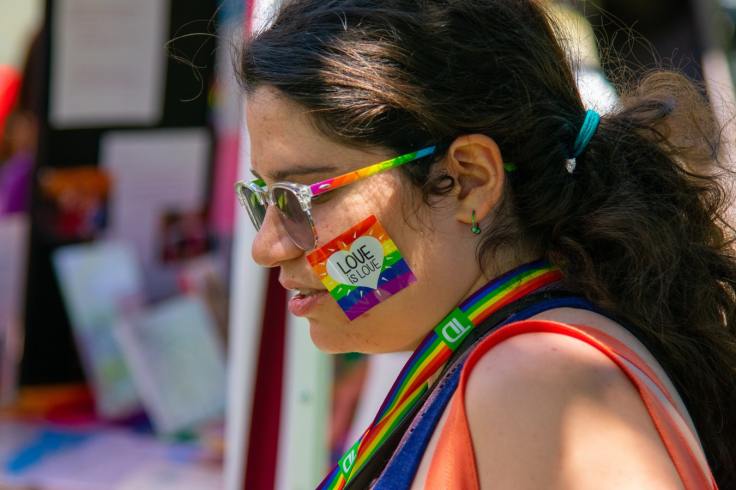Senior lecturer Caroline Nielsen writes:

Love is Love: Welcome to UK LBGTQ+ History Month!
February is UK LGBT+ History Month, an inclusive celebration of history.
Across the country, public events will be taking place to celebrate the long history and global diversity of LGBTQ+ experience. It aims to promote equality and diversity in communities, with a special emphasis on providing resources and support for LGBTQ+ people, young and old. It raises awareness of the diversity and complexity of human identity and relationships over time, highlighting the damaging effects of prejudice and discrimination. The theme for this year is poetry, prose and plays.
2019 marks the 14th anniversary of this public history event. It has certainly come a long way since 2005. The first LGBT+ History Month was faced with a number of tabloid news stories with barely disguised homophobia running through them (see the work of Robert Mills on this). LGBTQ+ history sometimes still suffers from a vague public misconception that it is an inappropriate form of biographic history which likes to ‘out’ historic individual’s intimate relationships and/or sexual preferences for either salacious entertainment or for political reasons. Discussing a historic person’s sexuality can still be controversial, especially if they were believed to have possibly been in a same-sex or ‘queer’ sexual or romantic relationship at some point in their lives. There has been debate about how appropriate it is to, in the words of one author, ‘open history’s closets’.[1] This view helped fuel another early misconception about the history of sexualities and LGBTQ+ experience; that it was just about what people historically liked to do with other people in bed.
Fortunately, attitudes are changing. UK museums and heritage institutions are increasingly open about their diverse histories and collections. This marks an increasing public awareness that same-sex relationships have always been part of human history. An individual’s sexual orientation and/or gender identity was, and is, a core part of their life. Knowing about a historic person’s attitudes towards their own sexuality and/or gender orientation can help us understand them and their world in a new way. LGBTQ+ history is not just about sex. It is about recognising the range and diversity of relationships and identities people had in the past, and how they understood them.
Studying the history of sexuality and LGBTQ+ experience help illuminates the origins of prejudice and discrimination in a society. It can remind us that our society’s beliefs about gender, sex or same-sex intimacy may not be as old and unchanging as we once thought. It highlights that our definitions of behaviour and emotion are significantly shaped by the many diverse structures, cultures, customs and beliefs present in our wider communities and societies.
Let me give you an example of the role of definitions. When introducing the complexity of the history of sexuality in an undergraduate class, I begin with the 2006 World Health Organisation’s working definition of sexuality. It states:
‘…a central aspect of being human throughout life encompasses sex, gender identities and roles, sexual orientation, eroticism, pleasure, intimacy and reproduction. Sexuality is experienced and expressed in thoughts, fantasies, desires, beliefs, attitudes, values, behaviours, practices, roles and relationships. While sexuality can include all of these dimensions, not all of them are always experienced or expressed. Sexuality is influenced by the interaction of biological, psychological, social, economic, political, cultural, legal, historical, religious and spiritual factors.’
I am aware that this may not seem like an obvious place to start. The definition is broad and designed to be read as part of the WHO’s wider framework on sexual health. But its own recognition of the role of wider factors in peoples’ experience and articulation of their identity and emotions is important. The 2006 WHO definition focuses on everyone’s rights, irrespective of their identification or whether they are in a relationship or not.
It is certainly a far cry from some of WHO’s previous approaches.[2] WHO continued to class same-sex desire as a form of mental deviation until 1990. WHO wasn’t alone in this. The American Psychiatric Diagnostic and Statistical Manual of Mental Disorders (DSM) listed it as a type of mental deviation from 1973 until 1987 (it had been a mental disorder in the first edition published 1952). These particular classifications were reflections of the marginalisation and stigmatisation of same-sex sexual relationships present in many mid 20th century societies. Sadly, LGBTQ+ people around the world still face the legacy of the earlier definitions.
I believe that we should always include the histories of gender, race, identity, class, sexuality, and physical and mental health in our discussions of the past, no matter what it is. Not doing so risks making history appear exclusive and elitist, the preserve of a few rather than the experiences of the many. It can help perpetuate prejudice and discrimination, as mentioned above. To quote British Museum curator R. B. Parkinson:
‘all too often, written history is monolithic and not multiple, and it quietly suppresses aspects of life not considered ‘normal’ by the governing culture. But this need not be so: other views are possible … History does not belong only to the ‘mainstream’ victors, and ‘minorities’ should not feel that they are marginal. On a long view, no one occupies the centre. It belongs to all of us.’[3]
A sentiment I think we can all agree on.
LGBT+ History Month events are taking place across the country. For the calendar, go to https://lgbtplushistorymonth.co.uk/calendar/
If you would like to find out more about LGBT+ history in your local area, please also check your local archives websites for research guides, information on relevant collections, and on-going projects.
UK LGBT+ History Month is part of the international festival OUTing the Past.
Please also look out for my forthcoming post on this blog about resources for LGBTQ+ histories.
References:
[1] White, Gayle. “Outing the dead; Lincoln biography fans speculation on sex lives of 16th president, other historical figures.” Atlanta Journal-Constitution [Atlanta, GA], February 18, 2005, G1. Gale General OneFile (accessed February 1, 2020). https://link.gale.com/apps/doc/A128878738/ITOF?u=nene_uk&sid=ITOF&xid=70518ee3.
[2] On WHO’s definitions of sexual health over time see Weston Edwards and Eli Coleman, ‘Defining Sexual Health: A Descriptive Overview’, Archives of Sexual Behavior 33:3 (20040, 189-95.
[3] R. B. Parkinson, A Little Gay History: Desire and Diversity Across the World (London: British Museum Press, 2013), 118, 121.

